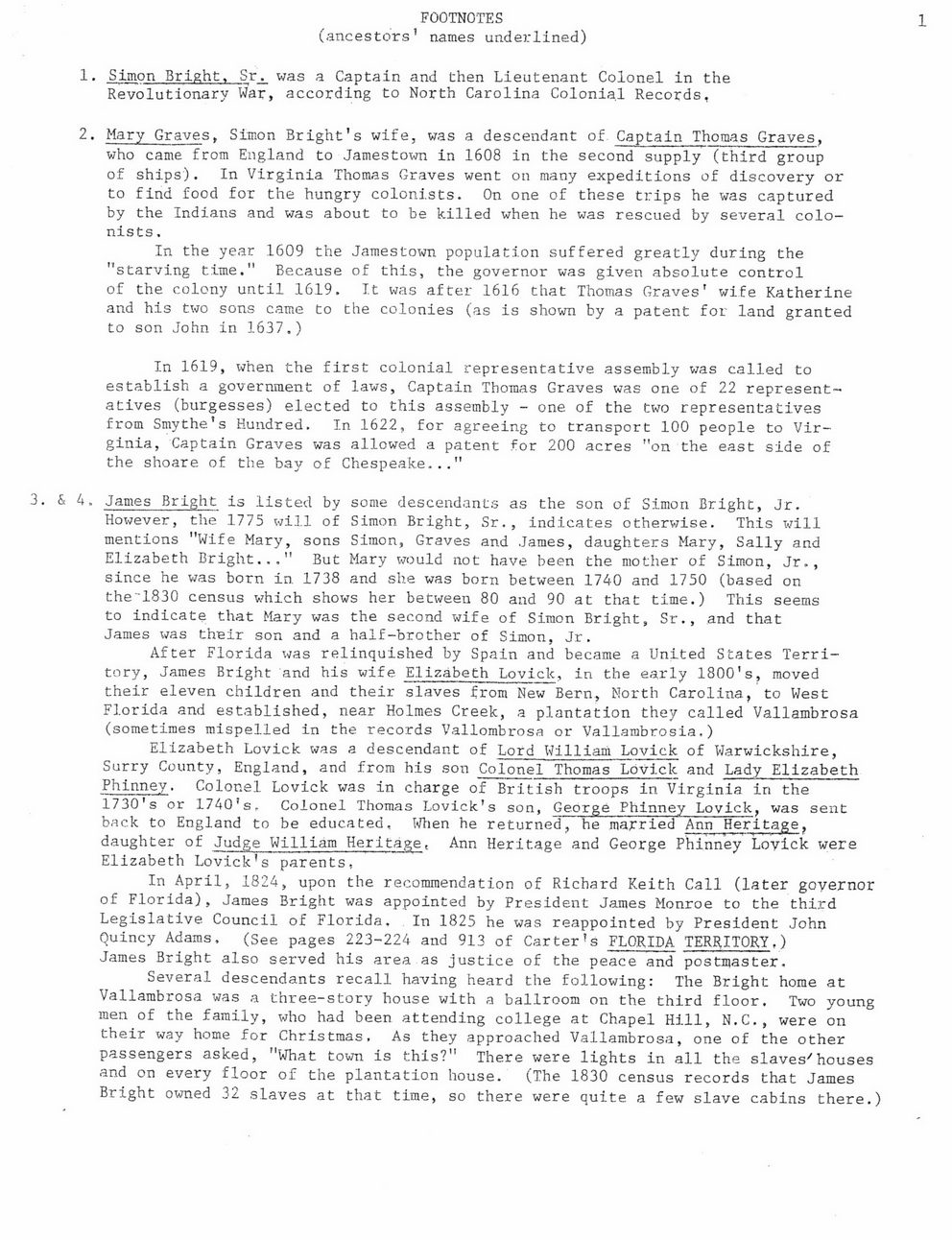This text was obtained via automated optical character recognition.
It has not been edited and may therefore contain several errors.
FOOTNOTES (ancestors1 names underlined) 1 1. Simon Bright. Sr. was a Captain and then Lieutenant Colonel in the Revolutionary War, according to North Carolina Colonial Records, 2. Mary Graves, Simon Bright's wife, was a descendant of Captain Thomas Graves, who came from England to Jamestown in 1608 in the second supply (third group of ships). In Virginia Thomas Graves went on many expeditions of discovery or to find food for the hungry colonists. On one of these trips he was captured by the Indians and was about to be killed when he was rescued by several colo- nists . In the year 1609 the Jamestown population suffered greatly during the "starving time." Because of this, the governor was given absolute control of the colony until 1619. It was after 1616 that Thomas Graves' wife Katherine and his two sons came to the colonies (as is shown by a patent for land granted to son John in 1637.) In 1619, when the first colonial representative assembly was called to establish a government of laws, Captain Thomas Graves was one of 22 represent- atives (burgesses) elected to this assembly - one of the two representatives from Smythe's Hundred. In 1622, for agreeing to transport 100 people to Virginia, Captain Graves was allowed a patent for 200 acres "on the east side of the shoare of the bay of Chespeake..." 3. & 4. James Bright is listed by some descendants as the son of Simon Bright, Jr. However, the 1775 will of Simon Bright, Sr., indicates otherwise. This will mentions "Wife Mary, sons Simon, Graves and James, daughters Mary, Sally and Elizabeth Bright..." But Mary would not have been the mother of Simon, Jr., since he was born in 1738 and she was born between 1740 and 1750 (based on the~1830 census which shows her between 80 and 90 at that time.) This seems to indicate that Mary was the second wife of Simon Bright, Sr., and that James was their son and a half-brother of Simon, Jr. After Florida was relinquished by Spain and became a United States Territory, James Bright and his wife Elizabeth Lovick, in the early 1800's, moved their eleven children and their slaves from New Bern, North Carolina, to West Florida and established, near Holmes Creek, a plantation they called Vallambrosa (sometimes mispelled in the records Vallombrosa or Vallambrosia.) Elizabeth Lovick was a descendant of Lord William Lovick of Warwickshire, Surry County, England, and from his son Colonel Thomas Lovick and Lady Elizabeth Phinney. Colonel Lovick was in charge of British troops in Virginia in the 1730's or 1740?s, Colonel Thomas Lovick's son, George Phinney Lovick, was sent back to England to be educated, Wien he returned, he married Ann Heritage, daughter of Judge William Heritaget Ann Heritage and George Phinney Lovick were Elizabeth Lovick?s parents, In April, 1824, upon the recommendation of Richard Keith Call (later governor of Florida), James Bright was appointed by President James Monroe to the third Legislative Council of Florida. In 1825 he was reappointed by President John Quincy Adams, (See pages 223-224 and 913 of Carter's FLORIDA TERRITORY,) James Bright also served his area as justice of the peace and postmaster. Several descendants recall having heard the following: The Bright home at Vallambrosa was a three-story house with a ballroom on the third floor. Two young men of the family, who had been attending college at Chapel Hill, N.C., were on their way home for Christmas, As they approached Vallambrosa, one of the other passengers asked, "What town is this?" There were lights in all the slaves7houses and on every floor of the plantation house. (The 1830 census records that James Bright owned 32 slaves at that time, so there were quite a few slave cabins there.)

Mitchell Part-of-the-Bright-Family-Tree-with-Footnotes-part2